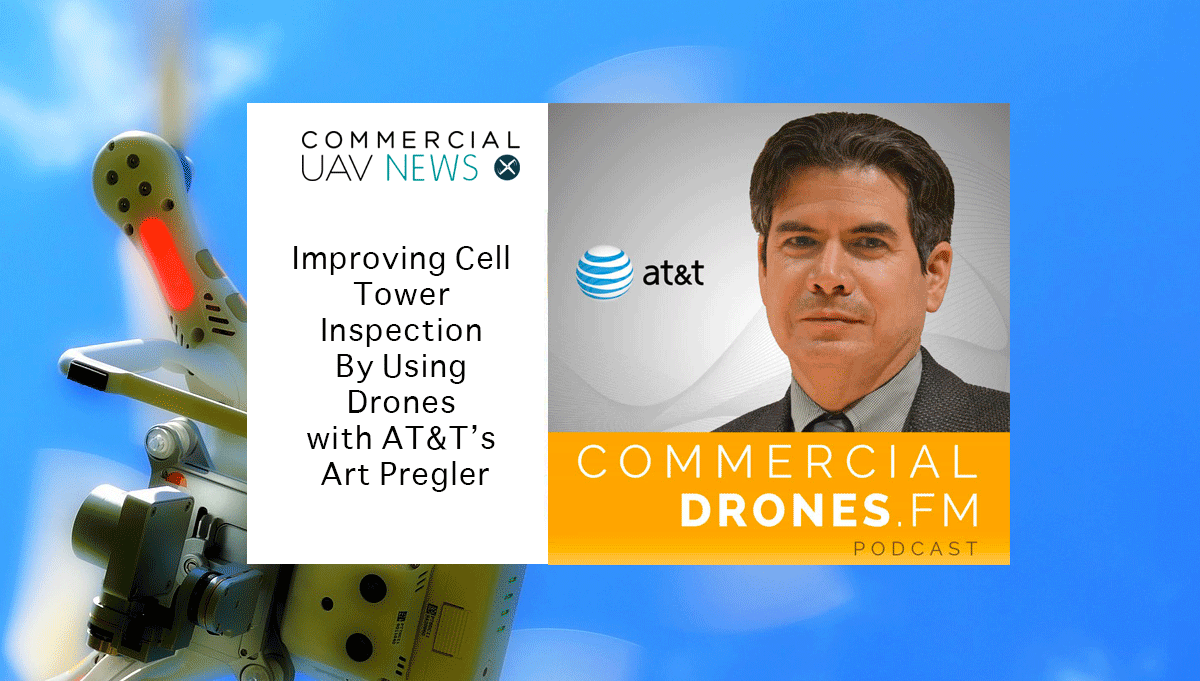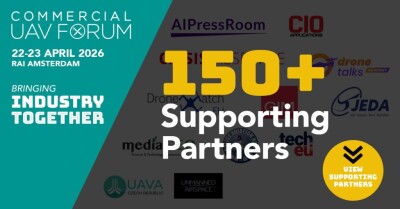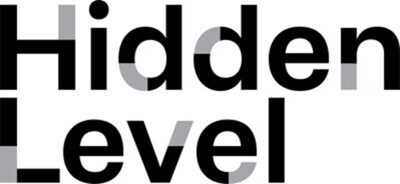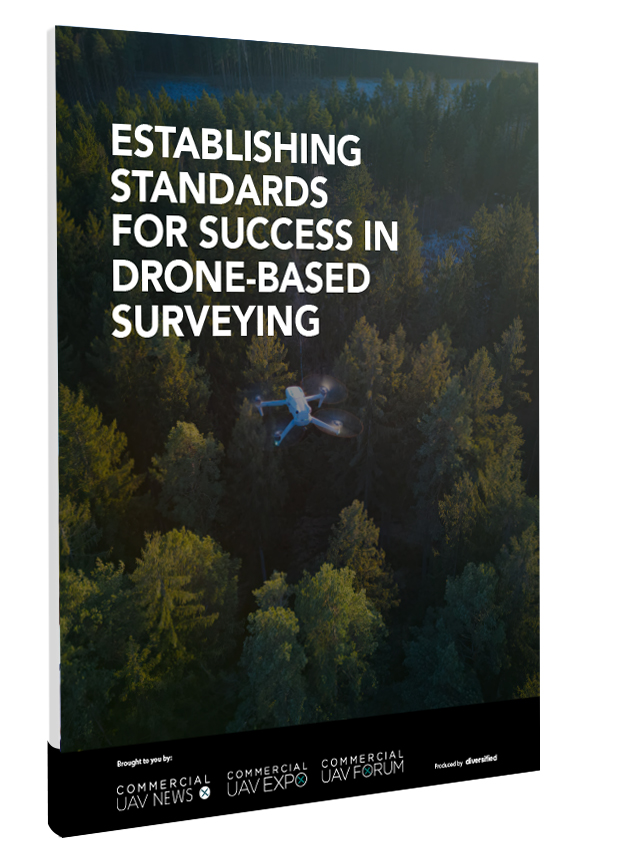While the improvements to safety and efficiency that drones can create for an organization have been well documented, figuring out what those improvements actually look like on a practical level has been an open question, especially when it comes to large enterprises. On episode #36 of the Commercial Drones FM podcast– Improving Cell Tower Inspection By Using Drones with AT&T’s Art Pregler – host Ian Smith discussed that very topic in detail with someone whose job it is to work out these practicalities for AT&T.
Art Pregler is the Director of Construction & Engineering Mobility Systems at AT&T, and he’s heavily involved in their efforts to leverage drone technology. Ian focused on the many ways in which AT&T is and will be using drones, and I caught up with Ian to further explore some of the topics that he discussed with Art. Find out what Ian has to say about the challenges associated with getting a 3D model or point cloud from cell towers, what it means to approach adoption without focusing on an immediate ROI and more.Read through the additional insights Ian provided before or after listening to the podcast below. You can also listen to the episode on iTunes or GooglePlay. Jeremiah Karpowicz: Art talked a little bit about his session at the Commercial UAV Expo, which was titled Improving Cell Tower Inspection Through Use of UAVs, but as he laid out, the company is doing a bit more than inspections with drones. Do you think their adoption of UAVs is a good example of how utilizing the technology can open up unexpected opportunities for organizations and even entire industries?Ian Smith: I really appreciate their ingenuity on use cases for drones. Checking around stadiums with drones to test cell signal is something that will affect nearly anyone attending an event at one of those venues. It's also something that I never would've thought of myself. Instead of using humans to walk around the entire stadium, taking measurements, they can use drones now and cut the time by hundreds of percent—from one week of work down to just 4 hours. That's a massive time savings for something that is not very glamorous or talked about much. It doesn't end there either, they recently announced their COW project, which was also successful. AT&T has done a great job adopting drones. The fact that the initial attraction of drones for AT&T stemmed from the safety perspective is poignant, because we’re always talking about how drones can impact efficiency, but safety is something that really resonates with professionals who have to literally climb up these infrastructures, isn’t it?If I were climbing hundreds of feet up a cell tower, I'd be welcoming drones with open arms. Besides safety, one of the other interesting uses Art mentioned in cell tower inspection is the fact that you can climb all the way up one of those towers and not even have the tools or equipment you need. That's a massive time sink to climb all the way back down and then up again, just to grab something you needed in the first place. Drones can help scope out the situation before ever sending someone to climb up the tower so that the maintenance technician knows exactly what to bring and what to expect. It's a double whammy, saving time and maintaining operational safety.You talked about the difficulty around being able to get a 3D model or point cloud from cell towers, and it sounded like that was an issue AT&T has dealt with, although Art did mention it depends on the use cases. What kind of challenges have you encountered in this area, and how have you been able to help users through it?Photogrammetry is a fickle beast. It's a bit tough to explain at times and at DroneDeploy, we say that sometimes, it's more of an art than a science. So many factors can affect the final result. When taking a bunch of images of a cell tower with many trusses and lattice work, the final collection of imagery will result in a rat's nest of criss-crossing features—wires, components, and beams on the tower that are located either in the foreground or background. Photogrammetric algorithms are not terribly great at making that distinction. The algorithms do their best to try and reassemble the imagery into a 3D model but when the imagery becomes confusing, it takes guesses. A few guesses on a data set is usually ok, but guessing around the 3D reconstruction of an entire cell tower means that you'll end up with an incomplete final product that causes more confusion than answers. For that reason, photogrammetry has not been the ideal choice for cell tower inspection. LiDAR and high zoom video cameras or individual photos themselves (not stitched together) are a better solution. While it no doubt stems from their focus on the safety impact of the technology, hearing Art say that their goal with drones is really just to break even, because the tools will become more efficient and effective over time, was really refreshing. I imagine many stakeholders at smaller companies might argue they aren’t in the position to only focus on breaking even, but it’s proof that there are many different ways to consider the adoption of the technology, don’t you think?Totally agree. AT&T does have the luxury of being one of the largest telecom and communications companies in the world but it does strike a chord when assessing the ways to think of ROI from drone investment. Some people might think that drones are a magical tool which can create immediate increases in efficiency (in some cases they can) but in reality they have to be the best tool for the job. So breaking even with a drone investment is actually an incredibly valuable way to approach this technology as it keeps expectations in check. What does AT&T’s use of service providers tell you about the opportunities that exist for drone operators in the space right now?There are a massive amount of opportunities in the drone industry right now. Drone service providers seem to have been waiting for this potential "moment of reckoning" where it would get so easy for their clients to fly drones on their own that they, as the service provider, would be out of a job, with their client taking on the responsibility themselves. That moment has not come and I'm unsure if it ever will. If you're a compliant, responsible, and professional drone service provider who cares about leveling yourself up and giving excellent service, you're going to have plenty of opportunities for obtaining and retaining business. Now, while AT&T might not come banging on your door, you will still be on the right track for a sustainable business.Subscribe
The information you submit will be stored and used to communicate with you about your interest in Commercial UAV News. To understand more about how we use and store information, please refer to our privacy policy.
March 7, 2017
Exploring How AT&T is Adopting Drones for the Present and Future – Commercial Drones FM Podcast Insights
















Comments